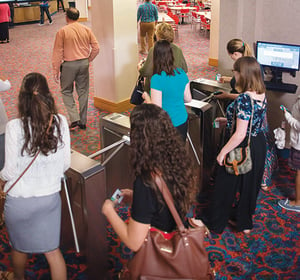Welcome to the second installment of our S.T.A.R.T.S.S.® blog series!
In this series, we’re taking a deeper look at our S.T.A.R.T.S.S Decision Methodology, which provides a framework for choosing the best security entrance and provider to meet your specific physical security needs. To see the introduction to the S.T.A.R.T.S.S. series, please click here.
Today’s topic: Security
As we discussed in the series kickoff, taking a proactive approach to securing your facility includes the installation of security entrances at your perimeter and other key access points. Security entrances can reduce or eliminate the possibility of tailgating or social engineering ploys to get around security guards, and provide a consistent preventive barrier to mitigate all types of risk.
Determining Your Required Level of Security
The first step in selecting the best security entrance(s) for your specific application is to determine the level of security required. This critical factor must align with your organizational security strategy for a successful implementation. Here are some key questions to address this factor:
- How important is preventing intrusion at each entrance? What is being protected inside and what liability are you exposed to if someone unauthorized enters?
- What other factors support or hinder security at this entry location? (for example, will security guards be present, or camera monitoring? Is this entry an “inner layer”?)
- What is the goal of the security entrance related to its capabilities? Simply deter infiltration, detect tailgating when it happens, or, outright prevent any infiltration?
The answers to these questions are the keys to determining the required security level at a particular location. Let’s look at the possible levels and how they influence the security entrance selection.
Level 1 Security Entrances: Crowd Control
Mechanical waist-high/tripod turnstiles fall into Level 1. These solutions are appropriate when the goal is to provide for basic crowd control. At this level, there is no detection or prevention of tailgating unauthorized entry. It is relatively easy to overcome the physical barrier (by climbing over, for example). Instead, tripods provide a checkpoint for authorized entry at a controlled rate and, they are usually supervised very closely by guards or staff.
Level 2 Security Entrances: Deterrence
Full-height turnstiles are Level 2 security entrances and are appropriate when the goal is to provide an increased visible and/or physical deterrent to unauthorized entry that is stronger than Level 1, but which cannot detect or prevent tailgating. At this level, casual intruders are discouraged before they even approach the entrance, because they know that intrusion will require a determined effort. It is possible for two small people to squeeze through together on a single authorization without detection, which is known as “piggybacking.”
Level 3 Security Entrances: Detection
Optical turnstiles are classified as Level 3 entrances because they provide an important step up in security: they provide a visual deterrent, and they include sensors that detect tailgating and unauthorized intrusions and can sound an audible alarm for action by security staff. The goal of detection in a Level 3 security entrance is to track when tailgating happens and notify security personnel so they can respond quickly.
Level 4 Security Entrances: Prevention
 Security revolving doors and mantrap portals are Level 4 entrances and provide the highest level of intrusion security by completely preventing tailgating and unauthorized entry on their own, without supervision.
Security revolving doors and mantrap portals are Level 4 entrances and provide the highest level of intrusion security by completely preventing tailgating and unauthorized entry on their own, without supervision.
The goal of Level 4 security entrances is complete prevention – that is, to make unauthorized entry into a facility close to impossible. They are designed to support this goal by requiring reliable authentication, preventing tailgating, and piggybacking. Security portals have the double benefit from their two-stage working principle (user has to go through two doors in sequence): they ensure a user is alone and, they enable matching of first credential (presented to enter the first door) and biometric identity (provided inside the portal to open the second door).
Next Step
Which of these levels applies to each entrance in your facility? Having this answer clearly in mind is the first step to a successful security entrance installation and implementation, and all the benefits that will flow from that upgrade.
Stay tuned for Topic #2: Throughput.
If you have any questions about S.T.A.R.T.S.S. or how to determine your security level, contact us directly – we love to help!
